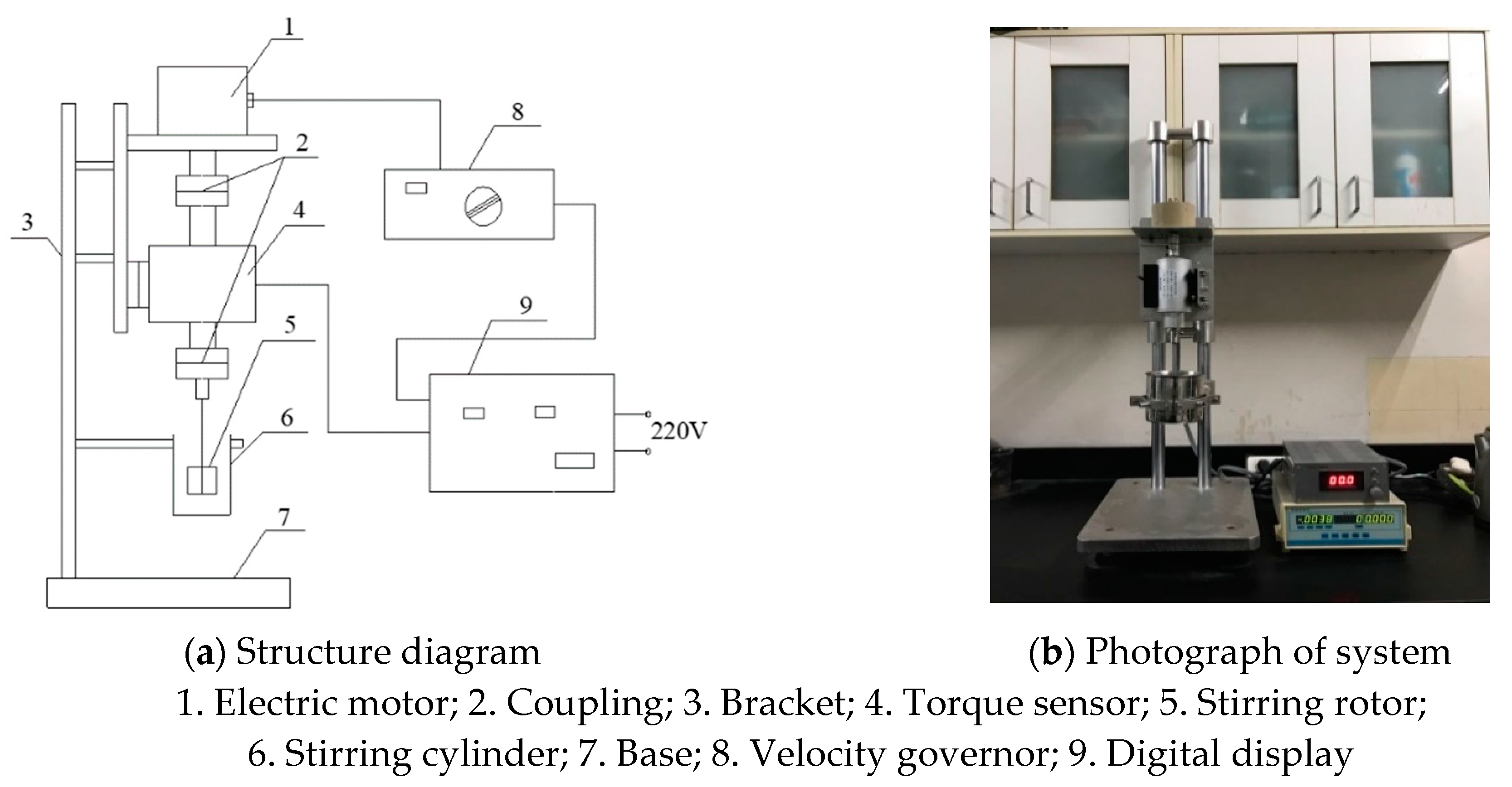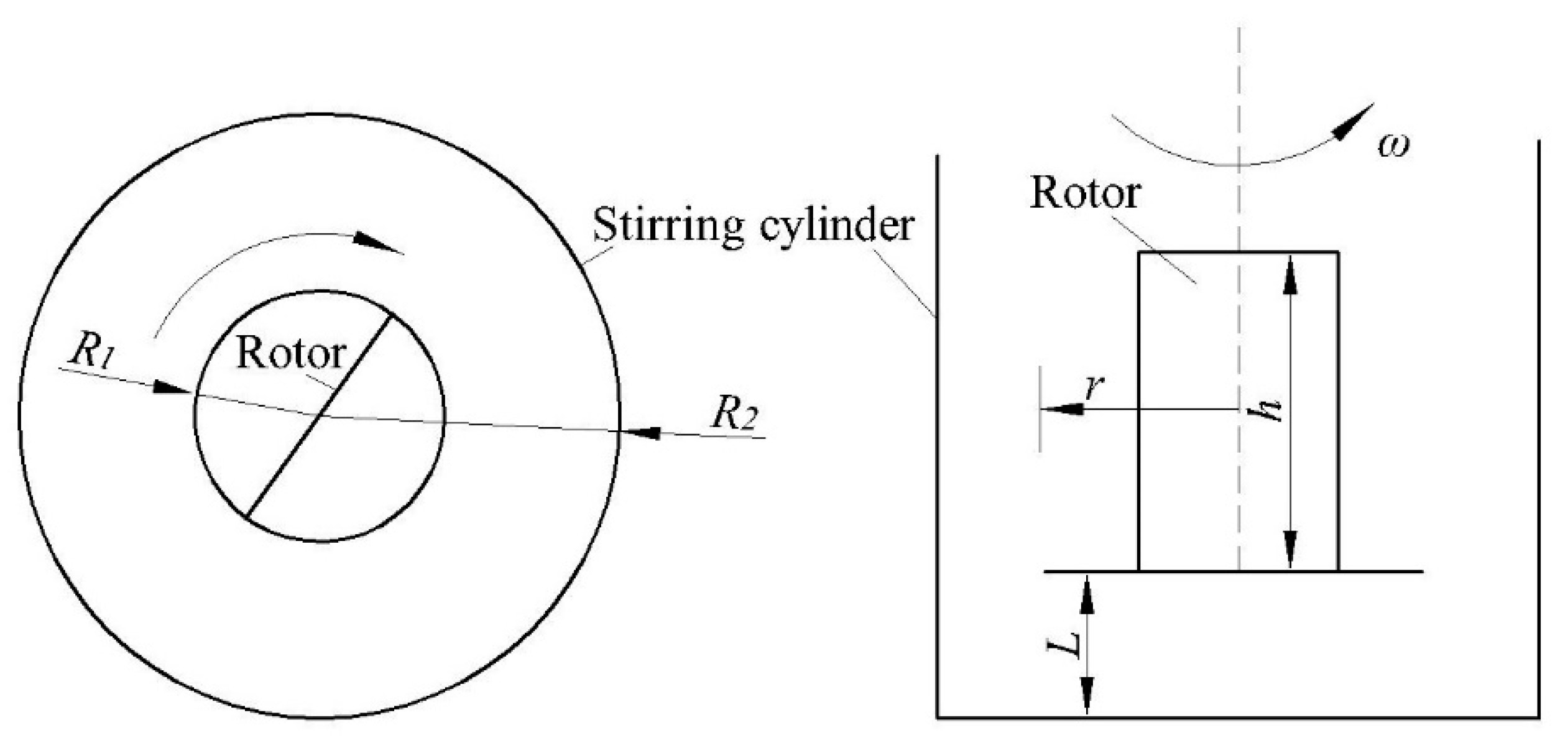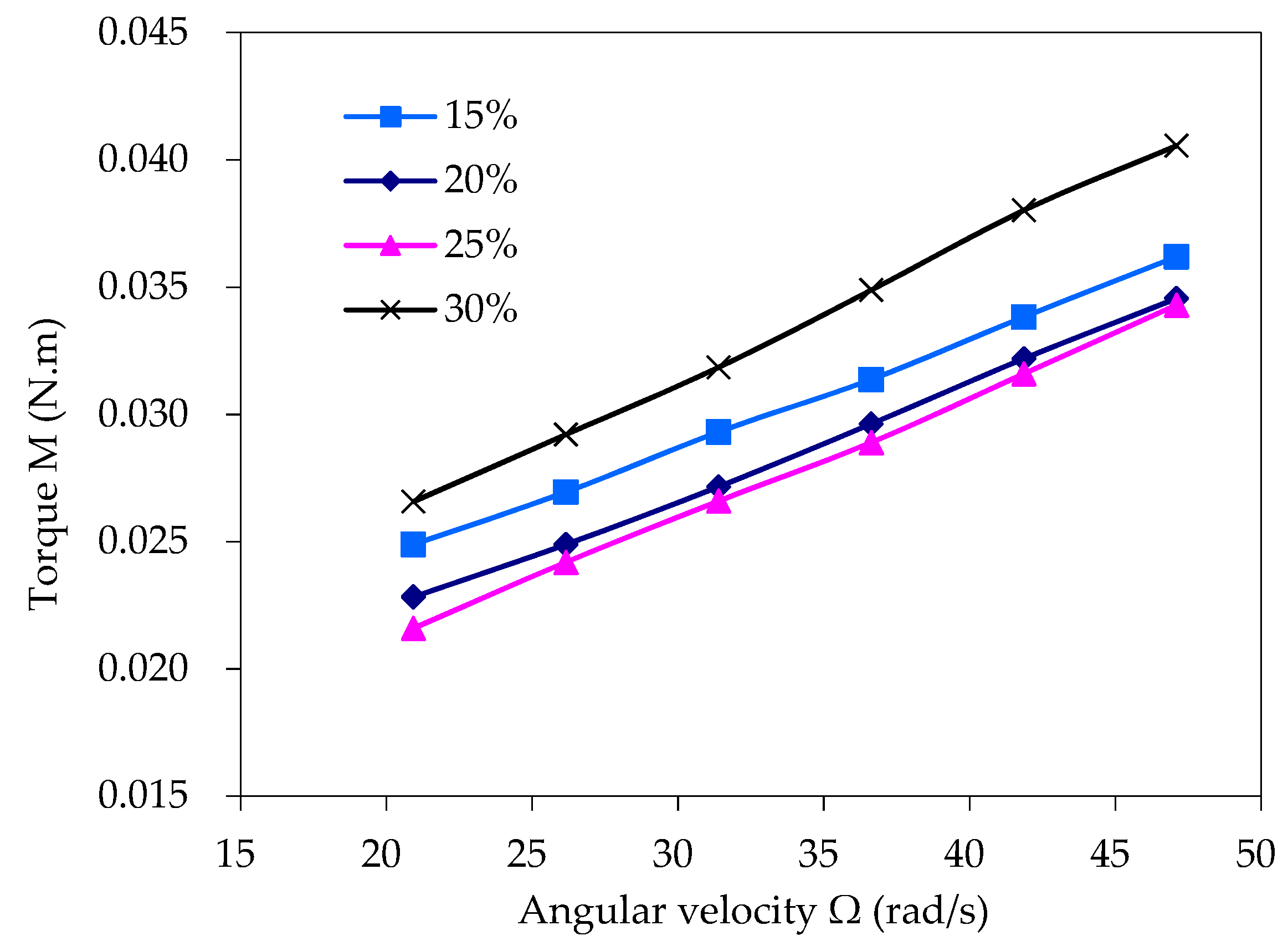Experimental Study and Application of Rheological Properties of Coal Gangue-Fly Ash Backfill Slurry
Abstract
1. Introduction
2. Structural Composition and Testing Principle of the HCGS Rheometer
2.1. Structural Composition of the HCGS Rheometer
2.2. Test Principle of the HCGS Rheometer
3. Experimental Analysis of Rheological Properties for Backfill Slurry
3.1. Experimental Scheme
3.2. Test Analysis
4. Discrimination of Flow State in a Backfill Slurry Conveying Pipeline
5. Engineering Applications
5.1. Determination of Friction Resistance Coefficient and Inner Diameter of the Backfill Pipeline
5.2. Backfill Pump Working Pressure
6. Conclusions
Author Contributions
Funding
Conflicts of Interest
References
- Hu, B.N. Backfill Mining Technology and Development Tendency in China Coal Mine. Coal Sci. Tech. 2012, 40, 1–5. [Google Scholar] [CrossRef]
- Sun, X.K.; Zhao, Q.M.; Shi, X.Y. Research and application on the technology of paste backfilling fully mechanized in residual strip pillar. J. Min. Safety Eng. 2017, 34, 650–654. [Google Scholar] [CrossRef]
- Zhang, H.X. Thinking on the Technology of Coal Mining under Buildings, Railways and Water-body in Future. Coal Min. Tech. 2011, 16, 1–3. [Google Scholar] [CrossRef]
- Guo, W.J.; Zhang, X.G.; Shi, J.W.; Li, Y.Y. Present Situation of Research on Backfilling Mining Technology in Mines and Its Application Prospect. J. Shandong Univ. Sci. Tech. (Nat. Sci.) 2010, 29, 24–29. [Google Scholar] [CrossRef]
- Huang, Y.C.; Feng, R.M.; Wang, H.P.; Zhao, W.P.; Liu, Y.F. The Coal Mining Mode of Paste-like Fill and Its Application Prospects. In Proceedings of the Advances in Civil Engineering, Pts 1–6, Kunming, China, 29–31 July 2011; pp. 3744–3748. [Google Scholar]
- Hui, G.L. Present Situation and Development of Filling Mining Technology in Coal Mines in China. Coal Eng. 2010, 2, 21–23. [Google Scholar]
- He, L. Application and Analysis of Filling Mining Methods of Coal Mines. Energy. Energy Conserv. 2016, 9, 183–184. [Google Scholar] [CrossRef]
- Li, Z.B. Present Situation and Development Trend of Filling Mining Technology in Coal Mines in China. Sci. Tech. Innov. Appl. 2014, 23, 105. [Google Scholar]
- Liu, Z.G.; Hu, J.Y.; Yao, L.Z. Ways and methods to extend the service life of mines. Zhongzhou Coal. 2006, 1, 21–74. [Google Scholar]
- Zhang, H.X.; Guo, W.J. New Technology of Coal Mining under Buildings, Railways and Water-Body; China University of Mining and Technology Press: Beijing, China, 2008; pp. 81–89. [Google Scholar]
- Lu, Y.Z. Research on the Movement Law of Overburden Rock under the Control of Coal Gangue Paste-Like Cementing. Master’s Thesis, Central South University, Changsha, China, 30 June 2006. [Google Scholar]
- Liu, J.G.; Zhao, Q.B. Comprehensive mechanized filling coal mining. J. China Coal Soc. 2010, 35, 1413–1418. [Google Scholar] [CrossRef]
- Qiu, M.; Shi, L.Q.; Yu, X.G.; Gao, W.F.; Shi, Y.K. On preventing the high pressure water-inrush from floor with paste-like backfill mining. J. Min. Safety Eng. 2016, 33, 409–414. [Google Scholar] [CrossRef]
- Huang, Y.C. Mine Filling Theory and Technology; Metallurgical Industry Press: Beijing, China, 2014; pp. 199–203. [Google Scholar]
- Chen, Y.J.; Zhao, B.W. Comprehensive Mechanized Paste Filling Coal Mining Technology; China Coal Industry Press: Beijing, China, 2012; pp. 17–18. [Google Scholar]
- Yang, Z.Q.; Yao, W.X.; Gao, Q.; Gui, H.G. Filling process and key technology of Pipeline Gravity Transport for Rod Mill Sand Filling Slury. J. Xinjiang Univ. (Nat. Sci. Edit.) 2016, 33, 221–228. [Google Scholar] [CrossRef]
- Liu, T.Y. Filling Mining Technology and Application; Metallurgical Industry Press: Beijing, China, 2001; pp. 58–64. [Google Scholar]
- Wang, S.Y.; Wu, A.X.; Ruan, Z.E.; Chen, S.M. Rheological properties of paste slurry and influence factors based on pipe loop test. J. Central South Univ. (Sci. Tech.) 2018, 49, 2519–2525. [Google Scholar]
- Zou, Z.Q.; Gao, Q.; Nan, S.Q. Research on the Rheological Properties of Cementing Material with Full Tailings based on Fill Stoping. Met. Mine. 2012, 12, 132–135. [Google Scholar]
- Wang, G.J.; Chen, G.R. Coaxial cylinder viscometer and its application in architectural coatings industry. Chem. Build. Mater. 1987, 3, 9–11. [Google Scholar]
- Fei, X.J. Hydraulics for Slurry and Granular Material Transport; Tsinghua University Press: Beijing, China, 1994; pp. 52–56. [Google Scholar]
- Liu, K.R. Theoretical Foundation of Filling; Metallurgical Industry Press: Beijing, China, 2012; pp. 54–56. [Google Scholar]
- Senapati, P.K.; Mishra, B.K.; Parida, A. Analysis of friction mechanism and homogeneity of suspended load for high concentration fly ash & bottom ash mixture slurry using rheological and pipeline experimental data. Powder Technol. 2013, 250, 154–163. [Google Scholar] [CrossRef]
- Qiu, Z.F.; Cao, T.; Li, Y.S.; Wang, J.J.; Chen, Y.L. Rheological Behavior and Modeling of a Crushed Sandstone-Mudstone Particle Mixture. Processes 2018, 6, 192. [Google Scholar] [CrossRef]
- Ma, B.G. New Pumped Concrete Technology and Construction; Chemical Industry Press: Beijing, China, 2006; pp. 247–250. [Google Scholar]
- Deng, D.Q.; Gao, Y.T.; Yang, Y.L.; Wu, S.C. Rheological properties of full tailings slurry in pipeline transportation based on the hydromechanics. Chin. J. Eng. 2009, 31, 1380–1384. [Google Scholar] [CrossRef]
- Peng, X.C. Filling Theory and Application; Central South University of Technology Press: Changsha, China, 1998; pp. 94–96. [Google Scholar]
- Wang, X.M.; Xiao, W.G.; Zhang, Q.L. Deep Well Mine Filling Theory and Technology; Central South University Press: Beijing, China, 2005; pp. 101–104. [Google Scholar]
- Zhang, Q.L.; Xie, S.Q.; Zheng, J.J.; Wang, X.M. Sedimentation law research and transportation feasibility study of backfilling slurry. J. Chongqing Univ. 2011, 34, 105–109. [Google Scholar]
- Huang, W.X. Engineering Fluid Mechanics; Chemical Industry Press: Beijing, China, 2001; pp. 144–145. [Google Scholar]
- Wu, A.X.; Ai, C.M.; Wang, Y.M.; Yang, X.X.; Zhou, F.L. Test and mechanism analysis on improving rheological property of paste with pumping agent. J. Central South Univ. (Sci. Tech.) 2016, 47, 2752–2758. [Google Scholar]
- Wang, X.L.; Sun, Q.F. Research on Pipeline Transportation Pressure of Shangzhuang Mining Area at Canzhuang Gold Mine. Mod. Min. 2019, 35, 111–114. [Google Scholar]
- He, Y.M.; Xiong, S.Y.; Lin, C. Scheme Selection and Pipeline Optimization of Suichang Gold Mine Filling System. Mod. Min. 2019, 35, 146–148. [Google Scholar]
- Gan, D.Q.; Gao, F.; Chen, C.; Zhang, Y.B.; Lu, H.J. Study on Resistance Loss of Full-tailings Filling Slurry with High-concentration in Pipeline Transportation. Min. Res. Dev. 2016, 36, 94–98. [Google Scholar] [CrossRef]
- Gan, D.Q.; Xue, N.; Liu, Z.Y.; Xue, Z.L.; Jia, Y.N. Exploration and Optimization of Resistance Loss of Pipes Filled with Full Tailed Sand. Met. Mine. 2019, 7, 32–40. [Google Scholar] [CrossRef]






| Particle Size (mm) | 20–10 | 10–5 | 5–2.5 | 2.5–1.25 | 1.25–0.63 | 0.63–0.31 | 0.31–0.16 | <0.16 |
|---|---|---|---|---|---|---|---|---|
| Content (%) | 18 | 23 | 17 | 12.5 | 9 | 5.5 | 5.5 | 9.5 |
| Groups | Variable | a | b | |
|---|---|---|---|---|
| A. Mass concentration (%) | 76 | = 4.25 × 10−4 + 8.88 × 10−3 | 4.25 × 10−4 | 8.88 × 10−3 |
| 77 | = 4.48 × 10−4 + 9.50 × 10−3 | 4.48 × 10−4 | 9.50 × 10−3 | |
| 78 | = 4.75 × 10−4 + 1.15 × 10−3 | 4.75 × 10−4 | 1.15 × 10−3 | |
| 79 | = 5.07 × 10−4 + 1.64 × 10−3 | 5.07 × 10−4 | 1.64× 10−3 | |
| B. Fly ash content (%) | 15 | = 4.32 × 10−4 + 1.49 × 10−3 | 4.32 × 10−4 | 1.49 × 10−3 |
| 20 | = 4.53 × 10−4 + 1.31 × 10−3 | 4.53 × 10−4 | 1.31 × 10−3 | |
| 25 | = 4.75 × 10−4 + 1.15 × 10−3 | 4.75 × 10−4 | 1.15 × 10−3 | |
| 30 | = 5.42 × 10−4 + 1.54 × 10−3 | 5.42 × 10−4 | 1.54 × 10−3 |
| Mass Concentration (%) | 76 | 77 | 78 | 79 |
| (Pa) | 54.0 | 57.8 | 69.9 | 99.7 |
| (Pa·s) | 2.37 | 2.50 | 2.65 | 2.83 |
| Fly Ash Content (%) | 15 | 20 | 25 | 30 |
| (Pa) | 90.9 | 79.5 | 69.9 | 93.5 |
| (Pa·s) | 2.41 | 2.52 | 2.65 | 3.02 |
| Mass Concentration | 76% | 77% | 78% | 79% | |
|---|---|---|---|---|---|
| = 0.1 m | 160 | 152 | 143 | 134 | |
| 2662 | 2670 | 2750 | 2967 | ||
| = 0.2 m | 321 | 304 | 287 | 269 | |
| 3217 | 3233 | 3389 | 3809 | ||
(m) | (m/s) | (kPa/m) | |
|---|---|---|---|
| Mass Concentration 77% | Mass Concentration 78% | ||
| 0.13 | 1.88 | 11.27 | 12.30 |
| 0.14 | 1.62 | 8.81 | 9.67 |
| 0.15 | 1.42 | 7.10 | 7.84 |
| 0.16 | 1.24 | 5.80 | 6.44 |
© 2020 by the authors. Licensee MDPI, Basel, Switzerland. This article is an open access article distributed under the terms and conditions of the Creative Commons Attribution (CC BY) license (http://creativecommons.org/licenses/by/4.0/).
Share and Cite
Wang, Y.; Huang, Y.; Hao, Y. Experimental Study and Application of Rheological Properties of Coal Gangue-Fly Ash Backfill Slurry. Processes 2020, 8, 284. https://doi.org/10.3390/pr8030284
Wang Y, Huang Y, Hao Y. Experimental Study and Application of Rheological Properties of Coal Gangue-Fly Ash Backfill Slurry. Processes. 2020; 8(3):284. https://doi.org/10.3390/pr8030284
Chicago/Turabian StyleWang, Yumin, Yucheng Huang, and Yuxin Hao. 2020. "Experimental Study and Application of Rheological Properties of Coal Gangue-Fly Ash Backfill Slurry" Processes 8, no. 3: 284. https://doi.org/10.3390/pr8030284
APA StyleWang, Y., Huang, Y., & Hao, Y. (2020). Experimental Study and Application of Rheological Properties of Coal Gangue-Fly Ash Backfill Slurry. Processes, 8(3), 284. https://doi.org/10.3390/pr8030284





